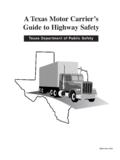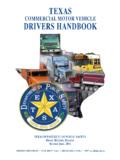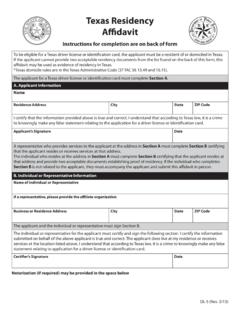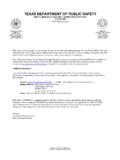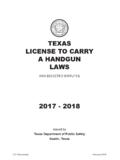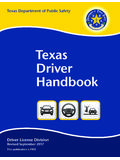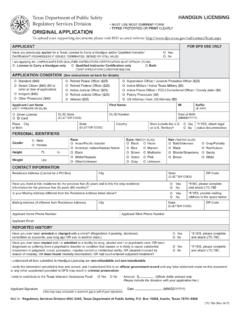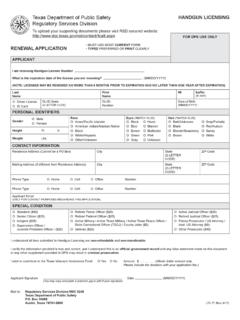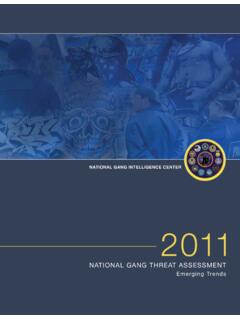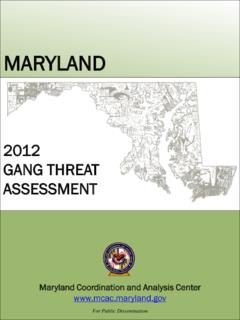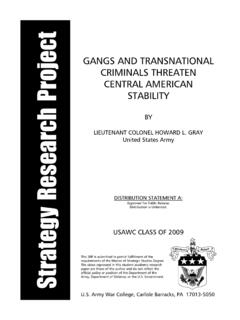Transcription of Texas Gang Threat Assessment
1 1 Texas gang Threat Assessment A State Intelli gence Estimate Produced by the Texas Joint Crime Information Center Intelligence & Counterte rror ism Division Texas Dep artment of Public Safety In collaboration with federal, state, and local law enforcement and criminal justice agencies August 2015 2 THIS PAGE INTENTIONALLY LEFT BLANK 3 Executive Summary The key analytic judgments of this Assessment are: Gangs continue to represent a significant public safety Threat to Texas due to their propensity for violence and heightened level of criminal activity. Of the incarcerated gang members within Texas Department of Criminal Justice prisons, over 60 percent are serving a sentence for violent crimes, including robbery (24 percent), homicide (16 percent), and assault/terroristic Threat (15 percent).
2 We assess there are likely more than 100,000 gang members in Texas . The Tier 1 gangs in Texas for 2015 are Tango Blast and Tango cliques (estimated 15,000 members), Texas Syndicate (estimated 3,400 members), Texas Mexican Mafia (estimated 4,700 members), Mara Salvatrucha (MS-13) (estimated 800 members), and Latin Kings (estimated 2,100 members). These groups pose the greatest gang Threat to Texas due to their relationships with Mexican cartels, high levels of transnational criminal activity, level of violence, and overall statewide presence. Gangs in Texas remain active in both human smuggling and human trafficking operations. gang members associated with human smuggling have direct relationships with alien smuggling organizations (ASOs) and Mexican cartels. These organizations were involved in and profited from the recent influx of illegal aliens crossing the border in the Rio Grande Valley in 2014.
3 gang members involved in human trafficking, including commercial sex trafficking and compelling prostitution of adults and minors, exploit their victims through force, fraud or coercion, including recruiting and grooming them with false promises of affection, employment, or a better life. Gangs identified as being involved in human trafficking in Texas in 2014 include Tango Blast, Texas Syndicate, Bloods, Crips, Gangster Disciples, and MS-13. Mexican cartels regularly use Texas gangs for the purposes of illicit cross-border smuggling. Members of Tier 1, Tier 2, and other gangs are sometimes recruited and tasked by cartels to carry out acts of violence in both Texas and Mexico. The relationships between certain gangs and cartels fluctuate based on cartel structures and cell alignments, gang alignment with specific cartels, threats or coercion, and familial ties. Traditional rivalries between gangs continue to diminish as members take advantage of opportunities to collaborate and achieve common criminal objectives, typically for financial gain.
4 Members of gangs such as the Bloods, Texas Syndicate, and Texas Mexican Mafia are working together to smuggle and sell drugs and weapons, among other crimes. In addition, law enforcement continues to observe gang members with hybrid memberships, where gang members claim multiple affiliations, which presents challenges in identifying and investigating gang activity. 4 THIS PAGE INTENTIONALLY LEFT BLANK 5 Table of Contents Title Page .. 1 Executive Summary .. 3 Table of Contents .. 5 Acknowledgments .. 7 State Intelligence Estimates .. 9 Preface .. 11 Introduction .. 13 Prioritization and Criteria .. 15 Increasing Threat from MS-13 in Texas .. 19 Barrio Azteca Statewide Threat Decreases .. 20 Law Enforcement Strategies .. 21 Texas Anti- gang (TAG) Centers .. 25 Regional Assessments .. 27 Transnational gang Members Among Border Influx .. 31 gang Organization .. 33 The Evolving Tango Culture.
5 35 gang Relationships .. 37 Ongoing Conflict Involving Bandidos Outlaw Motorcycle gang in Texas .. 37 gang Involvement in Criminal Activity .. 39 gang Involvement in Human Trafficking .. 40 Outlook .. 41 Appendix 1: Overview of Tier 1 and Tier 2 Gangs .. 43 Appendix 2: Other Contributing Agencies .. 51 References .. 57 6 THIS PAGE INTENTIONALLY LEFT BLANK 7 Acknowledgments The Texas Joint Crime Information Center collaborated with law enforcement and criminal justice agencies across Texas and the United States in the production of t his State Intelligence Estimate. Their contributions were invaluable in developing a comprehensive Assessment of the Threat posed by gangs in Texas , and they underscore the commitment among law enforcement and criminal justice agencies in Texas to share information and intelli gence in order to effec tivel y combat crime and improve public safety.
6 The Joint Crime Information Center thanks these agencies and center s for contributing to the pr oduction of this Assessment . It is also important to acknowledge the essential contributions of the many law enforcement agencies throughout Texas that routinely report gang and border-related incidents, which also contributed to this report. This includes Operation Border Star participants and agencies that contribute information to the Texas gang Investigative Database (TxGang). Contributing agencies are listed in Appendix 2. 8 THIS PAGE INTENTIONALLY LEFT BLANK 9 State Intelligence Estimates In order to enhance the state s ability to detect, assess, and prioritize threats to the safety and security of its citizens, the Texas Department of Public Safety implemented a State Intelligence Estimate process after consultation with the National Intelligence Council, based in part on the model of the National Intelligence Estimate.
7 State Intelligence Estimates are multi-agency assessments on issues relating to homeland security and public safety in Texas . They serve as the most authoritative and comprehensive analysis of these issues, and they are designed to provide law enforcement and government officials with the most accurate evaluation of current information on a given topic. State Intelligence Estimates are intended to provide an Assessment on the current status of an issue, but they may also include estimative conclusions that make forecasts about future developments and identify the implications for Texas . Unlike reports and assessments produced by an individual agency or center, State Intelligence Estimates draw on the information and expertise of multiple law enforcement and homeland security agencies across Texas . Such an approach is essential to developing a comprehensive Assessment of issues that affect the state as a whole.
8 By incorporating the perspectives and information from multiple agencies, the Texas Department of Public Safety is better able to produce assessments that support the development of proactive strategies and policies needed to address current and evolving threats to the state. 10 THIS PAGE INTENTIONALLY LEFT BLANK 11 Preface This Threat Assessment is submitted to the Governor and Legislature of Texas in response to the requirements of Texas Government Code In addition to meeting these requirements, this Threat Assessment provides a broad overview of criminal gang activity throughout the state of Texas . Texas Penal Code defines a criminal gang as three or more persons having a common identifying sign or symbol or an identifiable leadership who continuously or regularly associate in the commission of criminal activities. This Assessment was produced by the Texas Joint Crime Information Center in the form of a State Intelligence Estimate.
9 It includes the contributions of a wide range of law enforcement and criminal justice agencies in the state. The statements, conclusions, and assessments included in this report were reached based on a review and analysis of information from a variety of sources, including federal, state, and local reports of varying degrees of sensitivity and reliability, and open-source reporting. 12 THIS PAGE INTENTIONALLY LEFT BLANK 13 Introduction This Assessment updates the Texas gang Threat Assessment released in April 2014, and serves as the annual evaluation of the gang Threat in Texas . While many of the underlying trends and characteristics of gang activity have not changed substantially since last year, this report includes relevant updates and detailed information on several key aspects of gang activity. Quantitative information regarding gangs and gang activity is somewhat limited, and the available data is not necessarily comprehensive.
10 For example, the number of gang members in Texas is dynamic, with gangs regularly seeking new recruits, and existing members traveling or moving. Some law enforcement agencies may vary in their reporting, as well as in their awareness of gangs and indicators of gang activity. In addition, not all gang members are known to law enforcement, making the available information on identified gangs and gang members representative of only a portion of all gang activity. Finally, some law enforcement and criminal justice agencies currently maintain gang intelligence information in separate databases, several of which are not interoperable, creating impediments to the sharing of gang -related criminal intelligence information. Based on the requirements of Chapter 61 of the Texas Code of Criminal Procedure, the Texas Department of Public Safety was directed to create an online catalog to encourage and expedite the exchange of gang intelligence information between criminal justice agencies.
